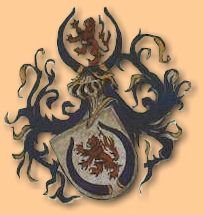|
 |
COAT OF ARMS
DETAILS
The Brankovics have left many sources for their
coat of arms - it can be seen on their money,
seals and clothes. Although there are some
variations two symbols are constant: bull's
horns and lion en passant. Most likely they
adopted bull's horns from the Lazarevics where
they wanted to pint out that they were the legal
successors of those rulers. This representation
is taken from Lazar Brankovic's seal from 1457. |
The
very last medieval Serbian dynasty, the Brankovics
ruled Serbia until the Turks conquered the country.
Vuk
Brankovic married Mara, Prince Lazar's oldest daughter
and he was the closest friend of the prince. They
fought together on June 28, 1389 in Kosovo against
Turkish invasion. Vuk was leading the right wing of
the army and even reached the center of the Turkish
camp but then Lazar was captured behind leaving a huge
gap in the troops position. Vuk decided to retreat in
order to save what could be saved and continue with
the defense of Serbia. However, in folks' songs Vuk
Brankovic is captured as a traitor - people could not
accept his decision to save the army and continue the
fight for freedom.
Vuk's
son, Djuradj was pretending to the throne of Serbia
and he even clashed with Prince Stefan
Lazarevic, his
cousin. They made peace and fought successfully
against the Turks in 1413. After his cousin's death,
Djuradj became new Prince and he was officially
acknowledged in 1429.
Djuradj
had four sons, three of which were blinded by the
Ottomans, and his daughter Mara had been married to
Murad II, living in the Turkish harem until his death.
Djuradj was succeeded by his son Lazar, who
unfortunately died already in January 1458.
Deprived
of a serious government, demoralized and abandoned,
Serbia proper was finally conquered by the Turks in
1459, when its last major outpost and capital,
Smederevo, was surrendered without a fight.
Nevertheless, even though the Serbian state was
conquered, the Brankovics remained powerful family and
they continued to influence the affairs in the country
two decades after the fall of Smederevo.

|
|
![]()